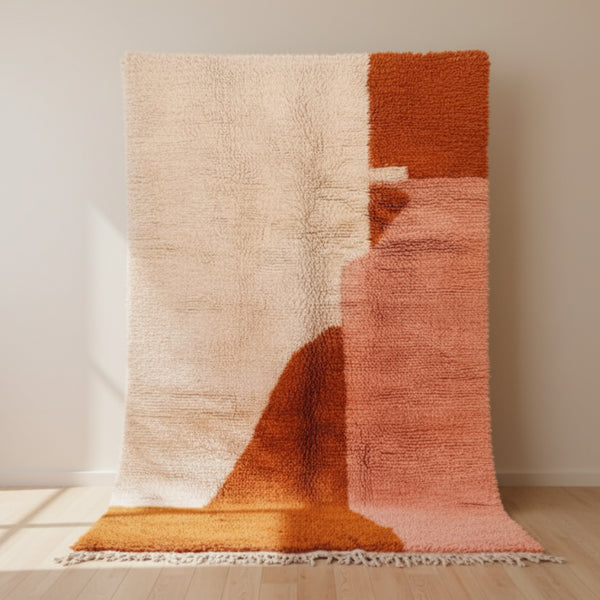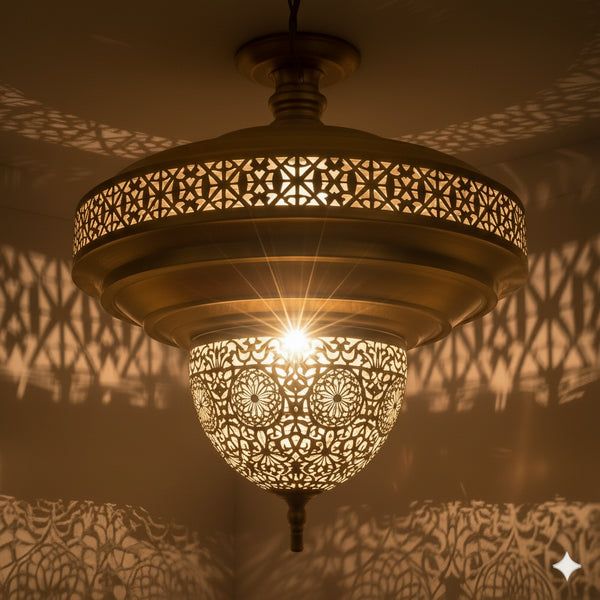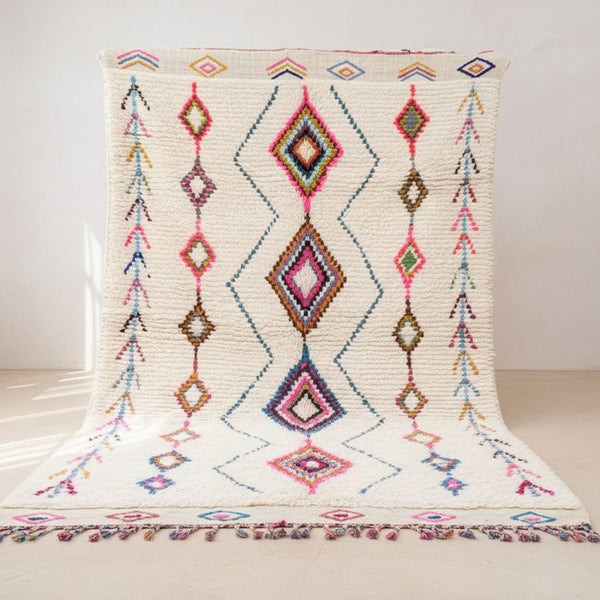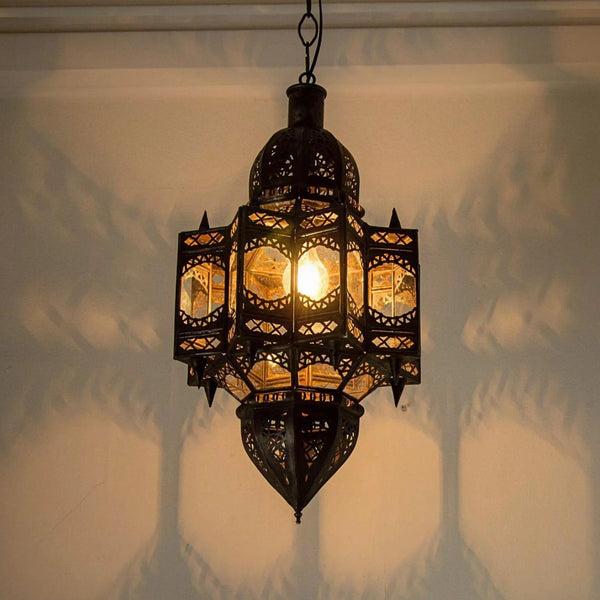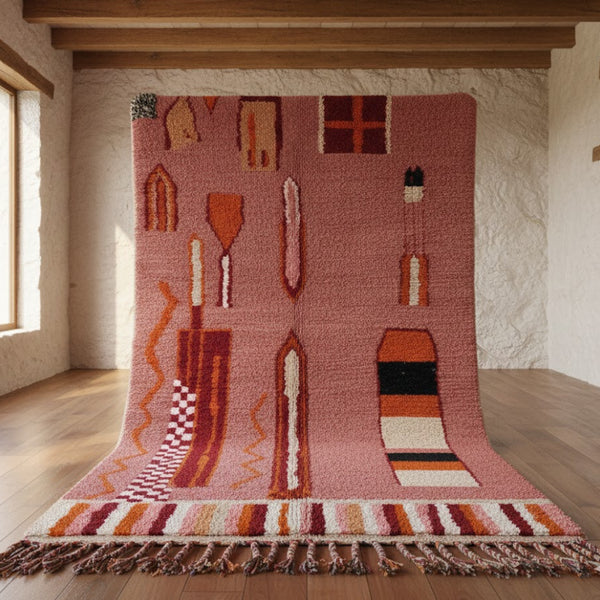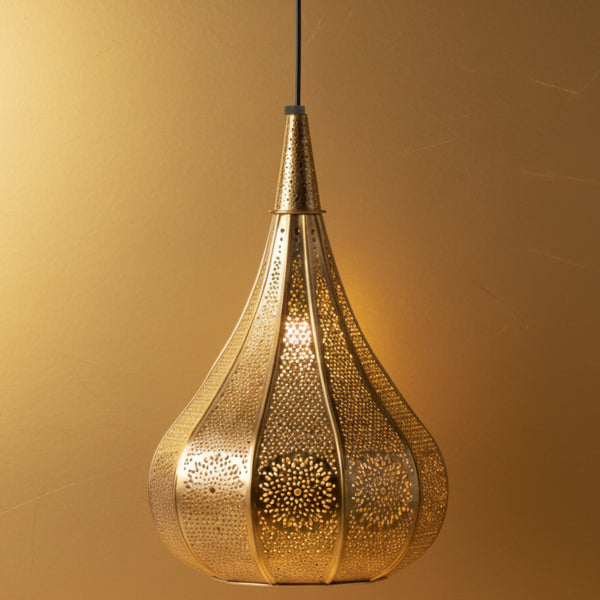Guide to Buying a Handmade Moroccan Wool Rug – Quality Checklist
Posted by AADIL KHAN
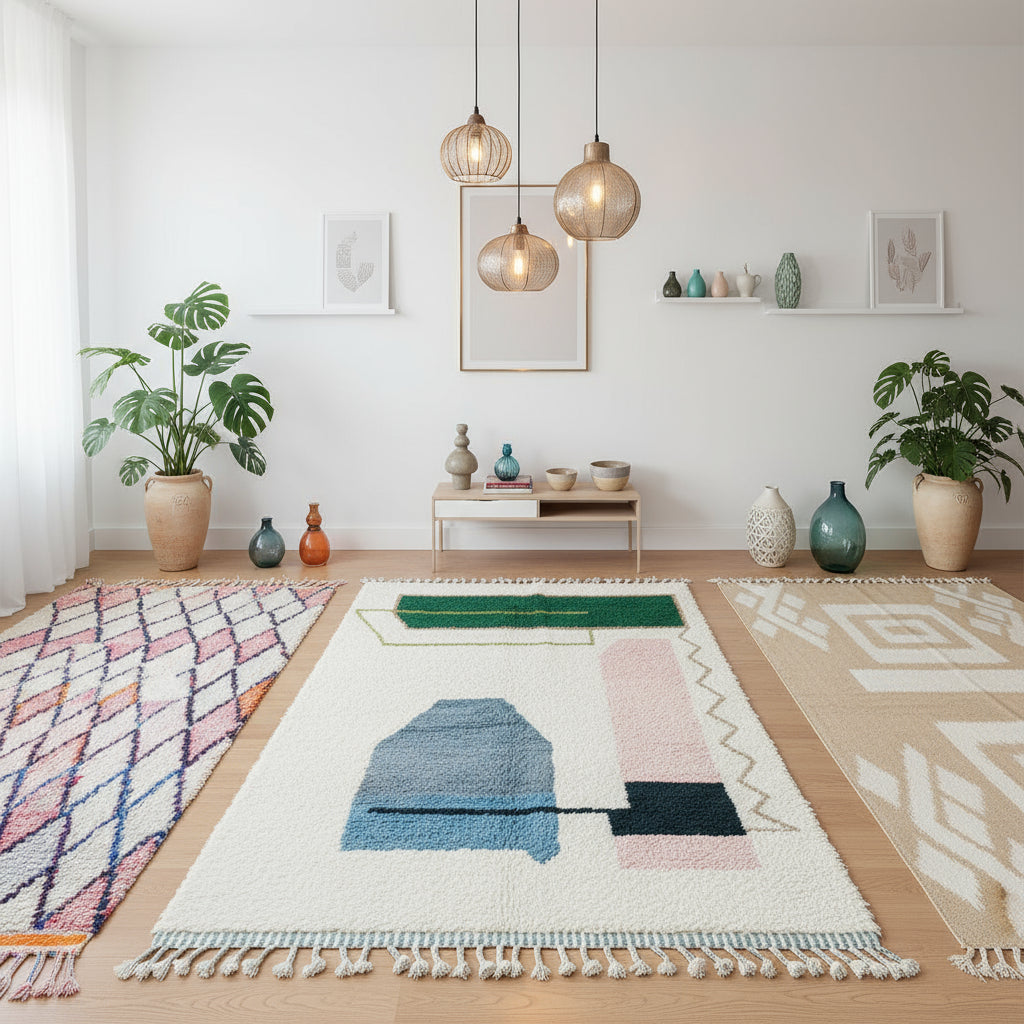
It can be hard to know where to start when you want to buy real Moroccan rugs because there are so many choices, from museum-quality works of art to cheap copies that fall apart in a few months. It's not always easy for untrained eyes to tell the difference between a real handwoven treasure and a mass-produced copy. This makes it easy to pay too much for something of lower quality or miss out on great pieces because you're not sure. This detailed quality checklist turns you from a hesitant shopper into a confident buyer. It gives you the expert knowledge you need to spot real craftsmanship, figure out what something is worth, and buy pieces that will look great in your home for years to come. These tried-and-true evaluation methods will make sure that every purchase meets the highest standards of quality, authenticity, and artisanal excellence that real Moroccan textiles stand for, whether you're shopping on online marketplaces or in specialty boutiques.
Why it's important to buy a high-quality handmade Moroccan wool rug
The difference between real handmade Moroccan wool rugs and machine-made ones goes far beyond how they look. It affects everything from how long they last and how comfortable they are to how environmentally friendly they are and how they help preserve Moroccan culture. Real handwoven rugs made by skilled Berber artisans take months of careful work to make, with each knot tied by hand using traditional methods that have been passed down through the generations. When properly cared for, these pieces can last fifty years or more and get more beautiful and interesting as they age. In contrast, machine-made copies usually show a lot of wear within five to ten years.
Quality assessment is very important for protecting your investment because it helps you figure out how much something is worth. Real handmade Moroccan wool rugs keep their value and even go up in value over time, especially if they have rare patterns or come from well-known weaving areas. The market for real pieces that are for sale is still strong, and collectors and designers are always looking for well-preserved examples of traditional craftsmanship. On the other hand, machine-made rugs lose value quickly and don't have much value on the secondary market, no matter what condition they were in when they were made.

Cultural authenticity links your purchase to living traditions that help rural artisan communities in Morocco's Atlas Mountain regions. Your money goes directly to women's cooperatives that pay fair wages and keep weaving traditions alive when you buy real pieces. Each real handmade Moroccan wool rug is more than just a piece of home decor; it's a piece of cultural heritage that should be protected for future generations.
When it comes to the environment, handmade items made from natural materials using traditional methods that have less of an effect on the environment are better. Real rugs are made with wool that comes from sustainable sources, natural plant-based dyes, and manual production methods that don't use electricity or create industrial waste. Machine manufacturing uses synthetic materials, chemical dyes, and processes that use a lot of energy, which hurts the environment and makes products of lower quality.
Learning about the craftsmanship that goes into real pieces
Traditional Berber weaving is one of the oldest living art forms in the world. For over a thousand years, master weavers have taught their apprentices how to weave and make patterns in an unbroken chain. To make one real rug, you need to learn a lot of new skills, like preparing the wool, dyeing it with natural dyes, planning the pattern, and actually weaving it. This usually takes years to master. Understanding this craftsmanship makes you appreciate it more and helps you spot the signs of real artisan work.
The amount of time it takes to make a real rug depends on its size, pattern complexity, and knot density. Most rugs take skilled weavers two to six months of full-time work to make. A 5x8 foot rug might have more than 200,000 individual hand-tied knots, and each one needs to be placed and tensioned just right to keep the structure strong and the pattern accurate. Authentic pieces cost a lot more than machine-made ones because they take a lot of work to make, but the quality and durability of the finished product make it worth the money.
Tribal heritage affects every part of making an authentic rug, from the symbolic meanings of traditional patterns to the specific techniques used by different regional groups. Beni Ourain weavers use different methods that have been passed down through their specific tribal lineage. These methods create construction signatures that experts use to tell if something is real. These cultural differences make each regional style unique, showing how the people who made it lived in a certain place, what they believed, and what their history was like.
The finished pieces show signs of hand craftsmanship that machines can't copy well, which shows the artisan skill involved. Slight changes in knot tension give the rug surface an organic texture, and small pattern irregularities show the human touch that is necessary for real work. Inexperienced buyers often mistake these traits for "flaws," but they are actually the most important signs of authenticity that set real pieces apart from fake ones.
Important Features of Good Wool Rugs
Knowing what makes high-quality wool rugs better than average ones gives you the confidence to judge the quality of the material, making sure that your investment will perform and last as long as you expect. Premium wool has certain physical properties that make it much more durable, comfortable, and attractive than lower-quality materials, no matter how well they are made.
One of the most important quality indicators for wool rugs is the length of the fibers. Longer staple fibers make stronger, more durable yarn that doesn't pill or mat. Authentic Moroccan wool has fibers that are 3 to 5 inches long, which gives it the heavy feel and strong texture that are typical of high-quality pieces. Short, weak fibers mean that the wool is of lower quality and will wear out quickly with normal use, making the rug look worn and less beautiful.
Quality wool has natural properties that make it stain-resistant because it contains lanolin, flame-resistant without chemical treatments, and hypoallergenic, which means it's safe for people with allergies. Real wool naturally controls humidity by soaking up extra moisture from the air and letting it out as the weather changes. This makes indoor spaces healthier. When wool is heavily processed or mixed with synthetic materials, these good qualities go away.
The texture of high-quality wool rugs is soft but strong, so they feel good underfoot without being too delicate or fragile. The wool should have a natural crimp that makes it very strong, so the pile can quickly bounce back after being compressed. If you run your hand against the pile direction, good wool springs back right away, but bad wool stays flat or takes a long time to recover, which means it is less durable.
You can tell how good the wool is by looking at it. The natural shine and color depth of the wool show its quality. Premium fibers also show light reflection along individual strands. The wool should look bright and alive, not dull or shiny in a fake way. Natural color variations should add depth and richness. When wool looks too uniform, it usually means that it is made from synthetic blends or heavily processed wool that doesn't have the character of natural fibers that haven't been processed much.
Differences in Moroccan Area Rugs by Region
Morocco's varied landscapes and cultural traditions have led to different styles of Moroccan area rugs in different parts of the country. Each style has its own patterns, colors, and ways of making them that show the tribal identity and local environment of the area. By understanding these differences, you can tell the difference between real regional pieces and appreciate the wide range of styles that exist in Moroccan textiles.
The Beni Ourain rugs from the Middle Atlas Mountains are probably the most well-known style around the world. They have cream or ivory backgrounds with bold geometric patterns in dark brown or black. These simple designs made with undyed natural wool are modern and stylish, but they also have a lot of traditional meaning. Authentic Beni Ourain pieces have thick, soft piles that keep you warm in the harsh mountain winters. The patterns on each piece are very different from each other, but they all have the same tribal look.
Azilal rugs from the central Atlas region have bright colors and abstract linear patterns that look very modern, even though they come from a traditional place. These bright Moroccan area rugs mix precise geometric shapes with free-flowing artistic expression. They often have pink, purple, yellow, and orange colors made from natural plant dyes. The patterns tell stories about the people who wove them, with each weaver using symbols to show their own feelings and experiences.

Boucherouite rugs show how creative people can be by using scraps of old fabric to make colorful, mixed-up patterns. These pieces were made out of need when wool was hard to come by, but they have since become well-known art forms that people appreciate for their unique look and environmental awareness. Even though authentic Boucherouite work uses different materials, it shows amazing skill in coordinating colors and patterns.
Kilim flatweave rugs from different parts of the world are lighter than pile rugs and have intricate geometric patterns made by special weaving methods. These reversible pieces are great for hanging on walls or in places with little foot traffic. They show off different building styles while staying true to their cultural roots. Knowing if you're buying pile rugs or flatweave kilims will help you set the right quality and use expectations.
The Ultimate Quality Checklist: What to Look for Before You Buy
By making a systematic plan for quality assessment, you can be sure to look at all the important factors before making a purchase, which gets rid of the guesswork and emotion that often lead to bad purchases:
1. Back Surface Examination: Flip the rug over and look closely at the back. You should be able to see the individual knots that make up the pattern on both the front and back of real hand-knotted pieces. Using a ruler, count the knots per square inch. Depending on the style of the region and the intended use, good pieces usually have 80 to 400 knots per square inch.
2. Check all four edges and corners for hand-finished work. Authentic pieces have selvage edges that are wrapped, bound, or woven into the structure. They are never glued or sewn together by machine. The corners should be securely finished by hand so that they don't come apart. Check for consistent workmanship that shows skilled craftsmanship throughout the whole piece.
3. Pattern Alignment Assessment: Examine the execution of patterns across the entire rug surface, observing that genuine handwork exhibits subtle variations in motif size, spacing, and execution that validate human craftsmanship. Perfectly mechanized symmetry suggests machine production, while variations in the overall pattern's integrity suggest real hand weaving.
4. Touch Test: Touch the wool directly and feel for its natural softness, heavy weight, and strong texture. Quality wool doesn't feel rough or too smooth; it has a natural range of textures in each fiber. The pile should feel thick and heavy, and it should bounce back well when pushed down.
5. Color Depth Evaluation: Look closely at how saturated and varied the colors are. Natural dyes make colors change slightly within a single hue, making rich, complex tones that synthetic dyes can't copy. Look for color changes that are natural and small imperfections that show traditional dyeing methods instead of mechanical uniformity.
6. Check the rug's structural integrity by laying it flat on the floor and seeing how it lies. Quality pieces naturally lay flat without curling, bunching, or changing shape. Check to see if the thickness is the same all the way around. This shows that the construction quality is even. Gently press on different parts to check how stable the structure is and how secure the knots are.
7. Smell Test: Natural wool should have a mild, organic smell that isn't too strong or chemical. Strong smells could mean that the materials are synthetic, have been treated with chemicals, or have been stored poorly, which could mean that the quality is bad.
How to Tell if Hand-Knotting and Weaving is Real
To tell the difference between real hand-knotted construction and machine-made construction, you need to look at certain technical features that show how the item was made. The back of a real hand-knotted rug shows each knot clearly, with small differences in knot size and tension that machines can't copy. If you have a magnifying glass, use it to see how each knot wraps around the foundation threads. This makes the strong structure that makes hand-knotted rugs so famous for their durability.
Fringe examination gives you immediate information about the authenticity of the construction. In real hand-knotted pieces, the fringe is the actual foundation warps that go beyond the woven area. This makes it an important part of the structure. Fringe on machine-made rugs is sewn or glued onto the finished edges, which makes it easy to see the difference between the fringe and the rug body.
Knot consistency analysis helps find real handwork by looking for the natural differences that people who weave can't help but make. Look at different parts of the back of the rug and pay attention to the small differences in knot size, tension, and placement. These organic differences show that something was made by hand, while mechanical perfection shows that something was made by a machine trying to look like something made by hand.
In real hand-knotted rugs, the pattern on the back should be as complicated as the pattern on the front, and the design should be easy to see from both sides. Many machine-made rugs have blurry or unclear patterns on the back, where glue or backing materials hide the construction details that would show where they were made.
Checking the quality of wool and the authenticity of the material
To check the quality of a rug, you need to know how real wool behaves differently than synthetic wool or wool-synthetic blends that are often used in lower-quality rugs. When you look closely at premium wool, you can see that it has certain traits that give you confidence in its authenticity before you buy it.
The burn test gives a clear answer about what the material is, but it has to be done carefully on a strand that isn't too noticeable. Real wool burns slowly and smells like burning hair, leaving behind dark, crushable ash. Instead of burning, synthetic fibers melt, leaving behind a hard plastic-like residue and a strong chemical smell. Blended materials show traits of both parts, but even a little bit of synthetic material hurts the natural properties that make wool better.
Testing for static electricity is a way to check materials without damaging them. To check for static charge, rub the rug surface hard and then bring your hand close. Natural wool doesn't make much static, but synthetic materials do, which makes the pile stand up or draw in small bits of dirt. This easy test quickly shows if the rug is made of synthetic materials without damaging it.
Examining fibers in good light reveals the small differences between individual wool strands that are typical of natural materials. Good wool has slight thickness differences along each fiber, natural crimp that gives it a three-dimensional texture, and a subtle shine that changes depending on the angle you look at it from. Synthetic fibers look uniformly smooth and consistent, but they don't have the natural look and feel of wool.
Another way to check if a material is real is to see how much water it can absorb. Put a small amount of water on the rug and see what happens. Natural wool slowly soaks up water, while synthetic materials either keep water out or soak it up too quickly. You should only do this test with the seller's permission and with care.
Learning about the authenticity of patterns and traditional designs
Real Berber patterns have cultural meanings and follow certain design rules that set them apart from fake reproductions made without understanding the culture. Learning to spot culturally accurate patterns will help you find real pieces and understand the deeper meaning these designs have in Berber communities.
Crosses represent meeting points or spiritual significance, while diamond shapes represent femininity and protection, and zigzag patterns represent water and life. Experts use these elements to authenticate because they show up in different combinations for different tribal groups, making regional vocabularies that are easy to spot. Real pieces use these symbols in the right sizes and places, following cultural rules that have been around for hundreds of years.
Pattern execution in authentic pieces shows that the designer knows more than just how to copy things that look good. The way motifs, spacing, and border treatments work together is based on traditional logic that takes into account both spiritual and practical factors. Weavers don't just put symbols anywhere; they make meaningful compositions that tell stories or ask for protection and prosperity.
Patterns with colors show both regional traditions and the choices of individual artisans. Authentic pieces have color combinations that are appropriate for their culture. Certain areas make indigo blues, saffron yellows, and madder reds from certain plants. These colors are typical of different regions. Knowing how colors are used in different areas can help you tell the difference between real pieces and fake ones.
Contemporary Moroccan rugs feature modern takes on traditional patterns, updating old designs to fit modern tastes while keeping the cultural meaning. These pieces show living traditions that are changing naturally, not old copies of history. To tell the difference between a respectful modern interpretation and a shallow copy, you need to know the basic design principles that real pieces follow, no matter how they are made.
Red Flags: Signs that Rugs Are of Bad Quality or Fake
Knowing what warning signs to look for can help you avoid common mistakes that inexperienced buyers make, which will save you money and disappointment while making sure your investment meets quality standards. These warning signs show up all the time in different places where people buy things, so you need to be careful no matter how good the seller looks or how good their reputation is.
The most obvious sign of a problem is unrealistic pricing, since real hand-knotted rugs need a lot of work and materials that need to be priced correctly. Be careful of prices that are much lower than the market rate for claimed levels of authenticity. Sometimes sales are real, but when rugs are heavily discounted and labeled as "handmade," it usually means they were made by machines or that the quality claims are false.
If a seller gives vague or evasive answers to specific questions about materials, where they came from, or how they were made, it could mean that they don't know what they're talking about or that they're hiding information about authenticity. Reputable dealers are happy to give you detailed information about the item's history, explain how it was made, and talk about its regional traits with authority. If someone can't or won't answer basic questions, it makes me very worried about the piece's authenticity.
If the patterns, knots, or colors are all the same, it means that the work was done by machine instead of by hand. Quality hand-knotted rugs have patterns that stay the same all the way through, but they also have small, natural differences that show they were made by people. Mechanical perfection means that the construction was made to look like traditional styles.
Some signs that a material is synthetic are an artificial sheen, a plastic-like feel, the ability to generate static electricity, and chemical smells that show non-natural fibers. These traits may not be clear in pictures, but they become clear when you look at them in person. This is why it's best to look at things in person when you can for big purchases.
Machine-made construction is easy to spot because the fringe is sewn or glued on instead of being part of the warp threads. This trait is a clear sign that the piece was made by hand, since authentic hand-knotted rugs always have fringe that naturally extends from the rug's foundation structure.
Where to Buy: How to Find Trustworthy Sources
Finding reliable sources for real Moroccan rugs takes research and due diligence to protect your investment and make sure you support businesses that do the right thing. Established dealers who focus on authentic textiles have direct connections with artisan cooperatives. These connections give them access to information about the rugs' history and expertise that goes beyond the physical rug.
Specialty rug dealers who sell real hand-knotted rugs have more knowledge than regular home decor stores, as their staff knows how to make rugs, what styles are popular in different parts of the country, and how to tell if a rug is of good quality. These experts usually give a lot of information about where each rug came from, what materials were used to make it, and when it was made. They also have strict return policies to back up their claims of authenticity.
Direct cooperative buying through groups that help Moroccan women artisans makes sure they get paid fairly and gives the most assurance of authenticity. Many cooperatives sell directly through websites or partnerships with other countries. They give out certificates that show the details of the weaving group and the artisan. These purchases help communities directly and cut out the extra costs that come with going through a middleman.
Online marketplaces are riskier because you can't see the items in person, so detailed photos and descriptions are very important. Look for sellers who have a lot of high-quality pictures that show the front, back, edges, and close-ups of the fringes so you can judge the quality. Video demonstrations that show the rug from different angles give people more confidence when they buy it online.
When talking to sellers, you should ask about the wool's source, how it was dyed, how long it took to make, how many knots there are, and who made it. Dealers who know what they're talking about answer with confidence and give specific information instead of vague generalities. Ask for proof of origin, certificates of authenticity, or cooperative identification that backs up the claimed origins.
Fair pricing and things to think about when investing
Knowing how pricing works for real items helps you set realistic budgets and understand how quality, size, and regional specialty affect value. Hand-knotted Moroccan rugs are big investments that can cost a lot of money depending on how long it takes to make them, how much the materials cost, and how much demand there is in the market.
Size is a big factor in price because larger pieces need more materials, time, and skill to make. A rug that is 5 by 8 feet might take three months to make, while a rug that is 9 by 12 feet might take six months or more from the same artist. Prices don't just go up with size; they often go up by a lot because it's harder to manage bigger pieces.
Knot density affects both the time it takes to make something and the final cost. More knots means better craftsmanship, which takes more skill and patience. Rugs with more than 300 knots per square inch cost a lot because they require a lot of skill and time to make.
Market values are affected by regional specialties and rarities. Rugs from well-known weaving areas or with rare patterns cost more. The highest prices in the market are for Beni Ourain pieces from certain cooperatives that are known for their high quality, or for antique rugs that have historical value.
Fair prices for real, high-quality rugs usually start at a few hundred dollars for small rugs and go up to thousands of dollars for bigger, better ones. If you see "handmade" rugs that cost about the same as machine-made ones, be careful. This could mean that the quality claims are false or that the rugs are poorly made.
Taking care of and maintaining things for a long time
With the right care, your rug will stay beautiful and useful for decades, protecting both its beauty and its value. Many people think that hand-knotted rugs need a lot of care, but they actually don't. Their natural materials and strong construction make them good for everyday use.
Using the right settings when vacuuming regularly gets rid of dirt and debris before they settle deep into the pile fibers, which stops abrasive damage that makes things wear out faster. Set your vacuum to the right height for your rug's pile and don't use beater bars on delicate or high-pile rugs. When you vacuum, go with the pile instead of against it. Once a year, flip the rug over and vacuum the back to get rid of dust that has settled through the structure.
Rotation keeps wear patterns from being uneven by making sure that all areas get the same amount of traffic. Every six months, turn your rug 180 degrees so that different parts of it face areas with a lot of foot traffic. By keeping certain parts from wearing out faster than others, this method greatly extends the life of rugs.
Professional cleaning gets rid of dirt and stains that regular home cleaning can't, and the cleaners use methods that are safe for natural materials and hand-knotted construction. Instead of setting arbitrary deadlines, schedule professional cleaning based on how much traffic there is and how dirty it looks. For moderate household use, this is usually every 3 to 5 years; for high-traffic installations, it is more often.
If you don't act quickly, spot cleaning can leave permanent stains. Instead of rubbing, which can damage fibers or spread stains, use blotting motions. Use mild detergent solutions that are safe for wool, but test them in areas that aren't very visible first. Professional help can help you get rid of certain stains without hurting natural dyes or fibers.
Quality rug pads that keep rugs from slipping and cushion them against hard floors are some of the ways to protect them. This cuts down on wear and tear from friction and impact. Use window treatments to block UV rays in bright rooms to keep natural dyes from fading. Take care of spills right away, and don't put rugs in places where they could get wet and mold or mildew could grow.
Conclusion: How to Buy with Confidence
With this complete quality checklist and expert knowledge, you now have the skills to confidently and authoritatively navigate the Moroccan rug market. The skills you've learned turn what could be a scary buying decision into a chance to buy real artisan crafts that will make your home better and support living cultural traditions. Have faith in your ability to spot signs of quality, ask smart questions, and know when you see real excellence. Your informed choice of a minimalist Beni Ourain, a bright Azilal, or another regional style will guarantee that you get a piece that will look great, feel great, and make you happy for many years to come. Your investment is more than just money; it connects you to centuries of artistic heritage and skilled artisans whose work deserves to be remembered and preserved. Step forward with confidence and make your purchase, knowing that you have the knowledge to make choices that honor both your home and the amazing artisans who make these textile treasures.
